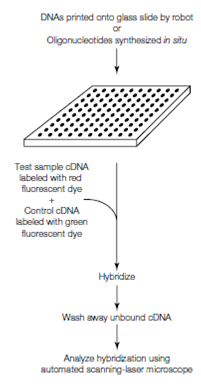DNA microarrays:
The methods defines above are limited in which only a relatively small number of samples can be analyzed at any one time. In compare, DNA microarrays gene chips and DNA chips, can analyze the expression of tens of thousands of genes concurrently. A DNA microarray is a huge number of DNA sequences which are spotted onto a glass slide in a pre-determined grid pattern; providing the large numbers of DNAs included, this is done robotically. In the other cases, instead of spotting DNA fragments the DNA microarray should be produced through synthesizing thousands of oligonucleotides on the glass slide in situ; as several as 40 000 oligonucleotides per square centimeter. The microarray holding DNA fragments or oligonucleotides can then be used to define the expression of every of these DNA sequences in the tissue or sample of interest through hybridization. In the terminology of hybridization, the DNAs or oligonucleotides on the microarray are the probe and the RNA in the tissue or sample is the target. To know how DNA microarrays are used, consider the following application shown in the figure. Imagine in which the target is to determine that genes are regulated through a newly-discovered hormone. The Cells are exposed to the hormone or test sample or left untreated control sample RNA is isolated from every sample and is used to synthesize cDNA using reverse transcriptase. While synthesizing cDNA from the test sample of RNA one of the nucleotide precursors is labeled with for instance, a red fluorescent dye so which the resulting cDNA is also tagged with this label. The control sample cDNA is similar labeled but with, for instance, a green fluorescent dye. The two cDNAs are mixed together and permits to hybridize to the DNA microarray. Any cDNA which does not hybridize is washed away and the DNA microarray is examined using an automated scanning-laser of microscope. Laser excitation of the microarray with light of the suitable wavelength to excite the relevant fluorophore and measurement of the intensity of the resulting fluorescence for each DNA or oligonucleotides spot allows the extent of hybridization with test (red) and control (green) cDNA to be deter- mined. Since the exact location of every DNA or oligonucleotide in the microarray is known, these data immediately indicate which genes are activated by the hormone (red spots), which type of genes are expressed only in the absence of the hormone of green spots and that genes are unaffected and are expressed together in the presence and absence of the hormone (yellow spots = red + green).
DNA microarrays are now broadly used to examine modification in gene expression in both plants and animals. For instance, in humans, they can be used to determine how particular diseases affect the pattern of gene expression (the expression profile) in several tissues or the identity (from the expression profile) of the infecting organism. Therefore, in clinical medicine alone DNA microarrays have large potential for diagnosis.

Figure: A typical use of a DNA microarray to determine the expression of thousands of genes simultaneously (see the text for details).